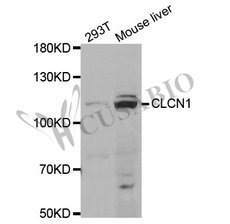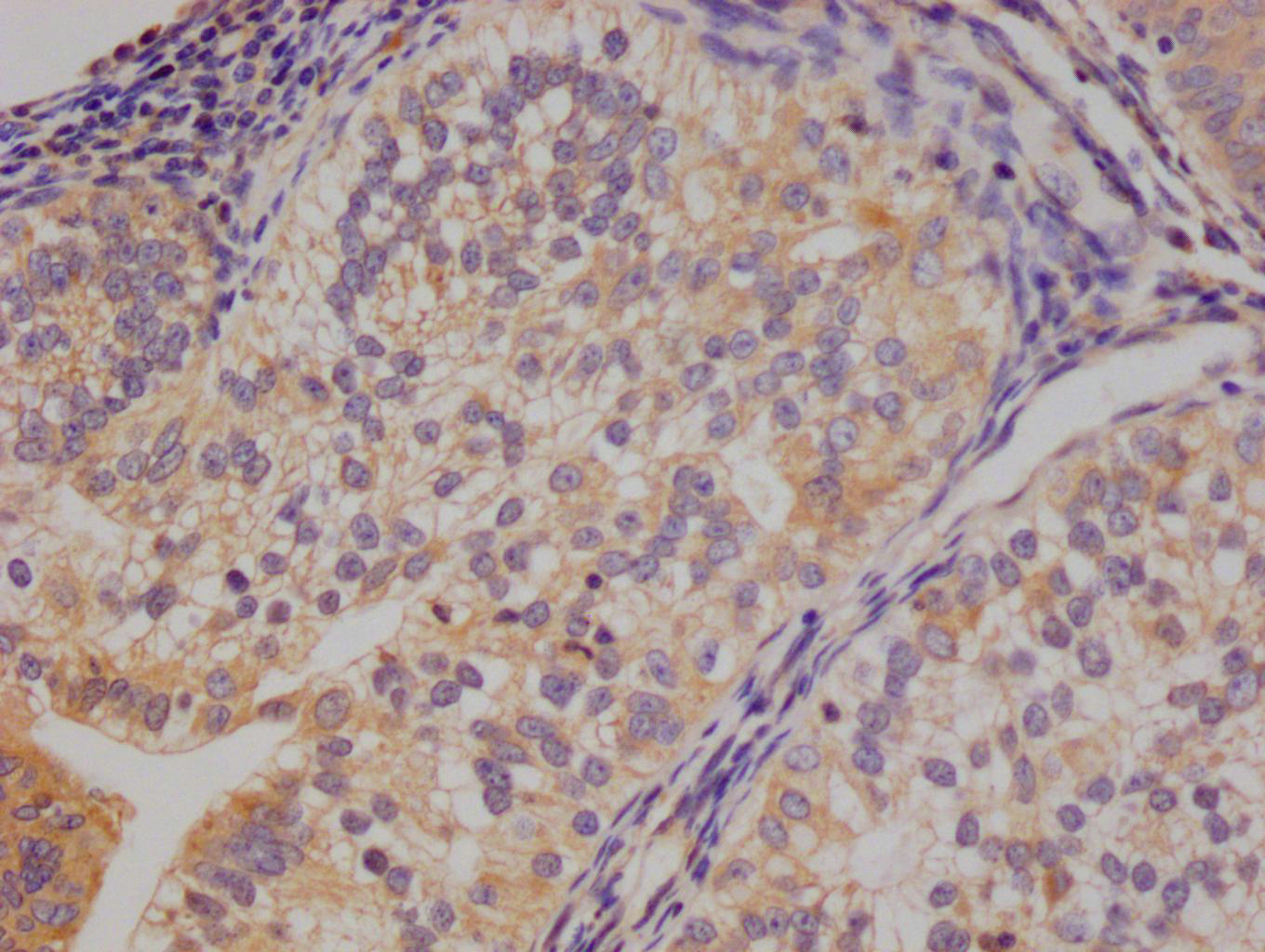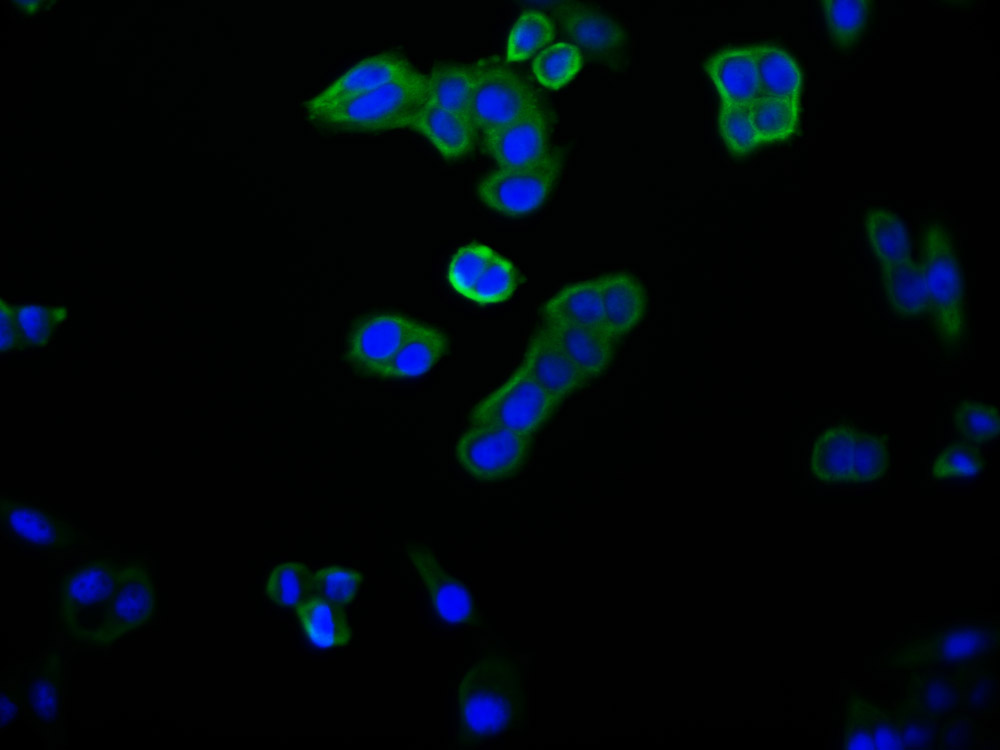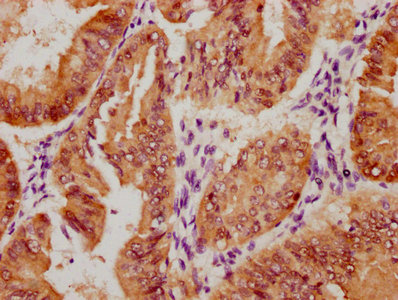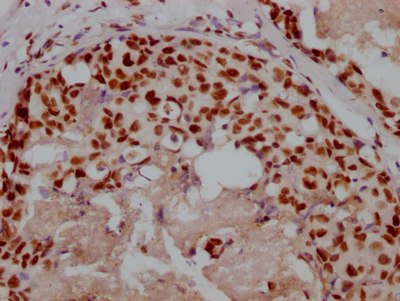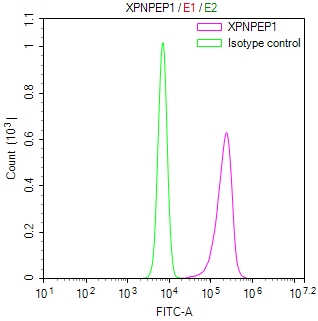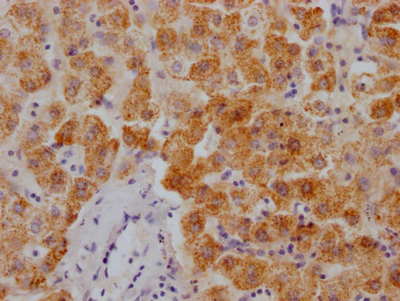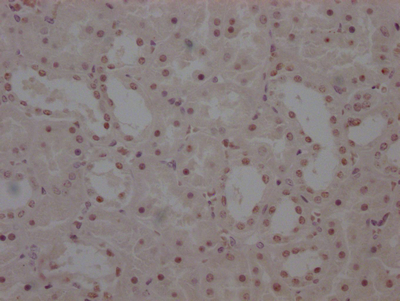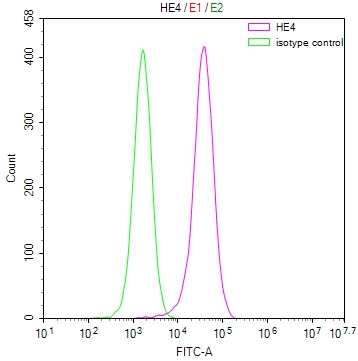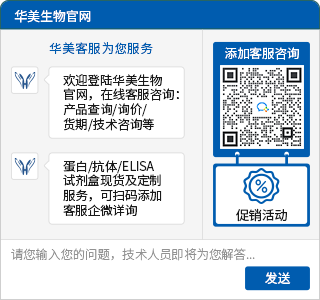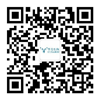CLCN1 Antibody
-
货号:CSB-PA005480
-
规格:¥2024
-
图片:
-
其他:
产品详情
-
产品名称:Rabbit anti-Homo sapiens (Human) CLCN1 Polyclonal antibody
-
Uniprot No.:P35523
-
基因名:CLCN1
-
别名:Chloride channel protein 1 antibody; Chloride channel protein antibody; Chloride channel protein skeletal muscle antibody; CIC 1 antibody; CIC1 antibody; ClC-1 antibody; CLC1 antibody; Clcn1 antibody; CLCN1_HUMAN antibody; MGC138361 antibody; MGC142055 antibody; skeletal muscle antibody
-
宿主:Rabbit
-
反应种属:Human
-
免疫原:Recombinant protein of Human CLCN1.
-
免疫原种属:Homo sapiens (Human)
-
标记方式:Non-conjugated
-
克隆类型:Polyclonal
-
抗体亚型:IgG
-
纯化方式:Antibodies were purified by affinity purification using immunogen.
-
浓度:It differs from different batches. Please contact us to confirm it.
-
保存缓冲液:Supplied at 1.0mg/mL in phosphate buffered saline (without Mg2+ and Ca2+), pH 7.4, 150mM NaCl, 0.02% sodium azide and 50% glycerol.
-
产品提供形式:Liquid
-
应用范围:WB
-
推荐稀释比:
Application Recommended Dilution Westernblotting 1:500~1:2000 -
Protocols:
-
储存条件:Upon receipt, store at -20°C or -80°C. Avoid repeated freeze.
-
货期:Basically, we can dispatch the products out in 1-3 working days after receiving your orders. Delivery time maybe differs from different purchasing way or location, please kindly consult your local distributors for specific delivery time.
相关产品
靶点详情
-
功能:Voltage-gated chloride channel. Plays an important role in membrane repolarization in skeletal muscle cells after muscle contraction. The CLC channel family contains both chloride channels and proton-coupled anion transporters that exchange chloride or another anion for protons. The absence of conserved gating glutamate residues is typical for family members that function as channels.
-
基因功能参考文献:
- The novel missense CLCN1 mutations is associated with a family affected with myotonia congenital. PMID: 29896741
- Loss-of- function mutations in the CLCN1 gene located on 7q35, are the primary contributors to the pathogenesis of Thomsen myotonia PMID: 27639085
- Regulation of CLC-1 chloride channel biosynthesis by FKBP8 and Hsp90beta as a molecular model for myotonia congenita has been described. PMID: 27580824
- the spectrum of CLCN1 mutations in patients with Myotonia Congenita PMID: 28427807
- Combining our results with the literature on Chinese populations indicates that 21 mutations in CLCN1 have been associated with myotonia congenital, while 7 mutations in SCN4A have been associated with paramyotonia congenita, 2 mutations in SCN4A have been associated with sodium channel myotonias. PMID: 27415035
- report a novel ClC-1 mutation, T335N, that is associated with a mild phenotype PMID: 27324117
- The present study is the first demonstration of ClC-1 regulation in active human muscle, and it provides a detailed description of the involvement of PKC and ClC-1 in the down-regulation of Gm during AP-firing activity in human skeletal muscle fibres PMID: 26857341
- This study, novel mutations in CLCN1 were detected, and the spectrum of CLCN1 mutations known to be associated with MC was expanded. PMID: 27118449
- our study confirms the presence of the myotonia causing CLCN1 mutations p.F167L and p.R105C in the Costa Rican population. PMID: 26510092
- Three novel mutations including 2 missense and one splicing were found in myotonia congenita patients. PMID: 26260254
- we characterized three other myotonic ClC-1 mutations. PMID: 26096614
- In 4 patients (3 families) with recessive MC, 4 CLCN1 variants were found, 3 of which are new. c.244A>G (p.T82A) and c.1357C>T (p.R453W) were compound heterozygotes with c.568GG>TC (p.G190S). The new c.809G>T (p.G270V) was homozygous. PMID: 26007199
- Our data are consistent with the idea that the CUL4A/B-DDB1-CRBN complex catalyses the polyubiquitination and thus controls the degradation of CLC-1 channels. PMID: 26021757
- investigated sequences of PRRT2 and CLCN1 in a proband diagnosed with paroxysmal kinesigenic dyskinesia and suspected myotonia congenita; the proband and his father harbored a PRRT2 c.649dupC mutation, and CLCN1 c.1723C>T and c.2492A>G mutations; first report showing the coexistence of PRRT2 and CLCN1 mutations PMID: 25205014
- This electrophysiological and clinical observations suggest that heterozygous CLCN1 mutations can modify the clinical and electrophysiological expression of SCN4A mutation. PMID: 25088311
- splicing mutations accounted for 23 percent of all pathogenic variants in the cohort of myotonia congenita patients; 4 were heterozygous mutations in 4 unrelated individuals: c.563G>T in exon 5; c.1169-5T>G in intron 10; c.1251+1G>A in intron 11 and c.1931-2A>G in intron 16 PMID: 24452722
- Six mutant forms of human CLC1 demonstrate modifications of channel gating behaviors and reduced chloride conductances that likely contribute to the physiologic changes of myotonia congenita. PMID: 24625573
- in Czech patients with myotonia congenita(MC), 34 differentCLCN1 mutations were identified in 51 MC probands (14 new mutations); structural analysis of mutations in the homology model of the dimeric ClC-1 protein was performed; results demonstrate structure-function relationships in the ClC-1 protein which are relevant to understanding the molecular pathogenesis of MC PMID: 24349310
- Early truncating mutations of CLCN1 precluding dimerization are expected to express an autosomal recessive phenotype in patients with myotonia congenita. PMID: 23893571
- The common CIC-1 gate likely occludes the channel pore via interaction of E232 with a highly conserved tyrosine, Y578, at the central anion-binding site. PMID: 24064982
- Two mutations in CN1 gene, inherited on the same allele as a heterozygous trait, abrogate disease expression, although when inherited singularly they were pathogenic. PMID: 23739125
- family reveals that compound heterozygosity of two dominantly inheritable disease mutations exacerbates the myotonia, suggesting the dosage effect of CLCN1 mutation responsible for myotonia congenita of Thomsen type. PMID: 23603549
- patients with myotonia congenita with very different phenotypes depending on mutation of ClC-1. PMID: 23933576
- Non-dystrophic myotonias are characterised by muscle stiffness during voluntary movement owing to delayed skeletal muscle relaxation caused by mutation in the CLCN1 skeletal muscle channel genes. PMID: 23417379
- Genetic testing in both patients reveals previously unidentified mutations in the CLCN1 gene specific to Myotonia Congenita PMID: 23483815
- Non-dystrophic myotonias are rare diseases caused by mutations in skeletal muscle CLCN1. PMID: 23771340
- functional and biochemical characterization of a myotonia mutation PMID: 23424641
- Our findings predict a dramatic reduction of the muscle fibre resting chloride conductance and thus fully explain the disease-causing effects of mutations C277R and C277Y of CLC1 in myotonia congenita PMID: 22641783
- The co-segregation of Myotonic dystrophy type 2 with a recessive CLCN1 mutation provided the explanation for the unusual clinical findings for juvenile onset of myotonia in a 14-year-old female with Myotonic dystrophy type 2 and her affected mother PMID: 22407275
- Molecular localization reveals the presence of CLCN1 mRNA transcripts in brain, previously believed absent in neurons. PMID: 23408874
- A single heterozygous missense CLCLN1 mutation, G233S, was associated with autosomal dominant myotonia congenita in a father & son.It affected the fast gate but not the common gate. PMID: 22790975
- CLCN1 mutations may cause a decrease in macroscopic chloride currents, impairing membrane potential repolarization and causing hyperexcitability in muscle membranes. PMID: 22521272
- ClC1 mutations exert gene dose effects and enhance myotonia and pain in DM2 in Germany. Additionally, the ClC1(236X) splice variant may contribute to myotonia in DM2. PMID: 23097607
- The spectrum of CLCN1 gene mutations in patients with nondystrophic Thomsen's and Becker's myotonias in Russia. PMID: 23113340
- Identification of new mutations leads to reclassification of Trp-118-Gly in CLCN1 as a moderately pathogenic mutation, and to confirmation of recessive (Becker) myotonia congenita. PMID: 23152584
- study describes a large Brazilian consanguineous kindred with 3 clinically affected patients with a Thomsen myotonia phenotype; they carry a novel homozygous nonsense mutation in the CLCN1 gene (K248X); none of the 6 heterozygote carriers show any sign of myotonia PMID: 22246887
- a new biological role for NAD suggests that the main physiological relevance may be the exquisite sensitivity to intracellular pH that NAD(+) inhibition imparts to ClC-1 gating. PMID: 22689570
- copy number variation in CLCN1 may be an important cause of recessive myotonia congenita. PMID: 22649220
- This study demonistrated that 26 different mutations in CLCN1 gene including 13 not reported previously. Among those 26 mutations, c.180+3A>T in intron 1 is present in nearly one half of the Spanish families in this series. PMID: 22094069
- Elucidating the pathophysiology of myotonia mutations will require the understanding of multiple molecular/cellular mechanisms of CLC-1 channels in skeletal muscles, including molecular operation, protein synthesis, and membrane trafficking mechanisms. PMID: 22187529
- Mutations in CLCN1 contributes to the pronounced variability in the myotonic phenotype. PMID: 21204798
- Identified a novel p.N440K sodium channel mutation that is located at the inner end of segment S6 of repeat I. PMID: 22106717
- Our data showed that slow activation gating of P480T ClC-1 mutation impaired the increment of chloride conductance during repetitive depolarization PMID: 21385601
- sequencing of CLCN1 gene in 2 families with myotonia congenita revealed heterozygous mutation (892G>A, resulting in A298T) in 1 family and compound heterozygous mutations (782A>G, resulting in Y261C;1679T>C, resulting in M560T)in the other family PMID: 21045501
- Closure of the common gate in ClC-1 channels is accompanied by a separation of the carboxyl-termini, whereas, with opening, the carboxyl-termini approach each other more closely. PMID: 21413926
- A novel p.L2871 mutation in the CLCN1 gene is described in a Honduran boy with myotonia congenita; his unaffected father carries the same mutation, most likely reflecting autosomal-recessive myotonia congenita. PMID: 20399394
- hClC-1 mutants expressed in whole-cell patch-clamped HEK293 cells showed that elimination of the carboxyl side chain in the E232Q mutation prevents fast gate closure at all voltages but common gating is also eliminated. PMID: 20398785
- A novel mutation, 568GG>TC(G190S) in the CLCN1 gene, is responsible for autosomal dominant myotonia congenita with a variable phenotypic spectrum. PMID: 19697366
- We investigated a 62-year-old man who had mild clinical features of myotonia congenita. He was found to have a novel heterozygous G-to-A nucleotide substitution at position 1652 in exon 15 of the CLCN1 gene. PMID: 20120005
- CLCN1 dysfunction alone does not result in skeletal muscle morphologic changes even in advanced stages of myotonia congenita, and MRI skeletal muscle alterations in myotonic dystrophy must be clear consequences of the dystrophic disease process PMID: 20047568
显示更多
收起更多
-
相关疾病:Myotonia congenita, autosomal dominant (MCAD); Myotonia congenita, autosomal recessive (MCAR)
-
亚细胞定位:Cell membrane; Multi-pass membrane protein.
-
蛋白家族:Chloride channel (TC 2.A.49) family, ClC-1/CLCN1 subfamily
-
组织特异性:Predominantly expressed in skeletal muscles.
-
数据库链接:
HGNC: 2019
OMIM: 118425
KEGG: hsa:1180
STRING: 9606.ENSP00000339867
UniGene: Hs.121483
Most popular with customers
-
-
YWHAB Recombinant Monoclonal Antibody
Applications: ELISA, WB, IF, FC
Species Reactivity: Human, Mouse, Rat
-
Phospho-YAP1 (S127) Recombinant Monoclonal Antibody
Applications: ELISA, WB, IHC
Species Reactivity: Human
-
-
-
-
-

